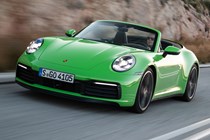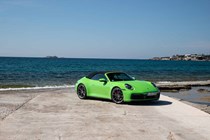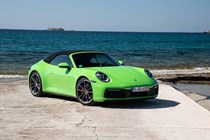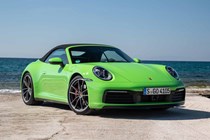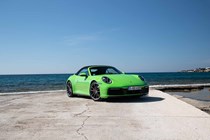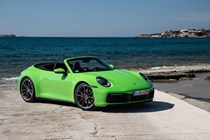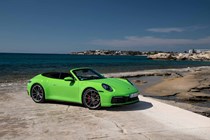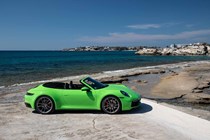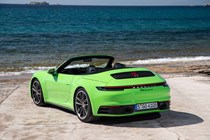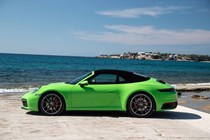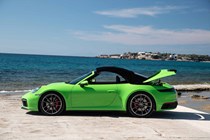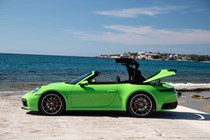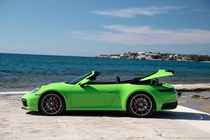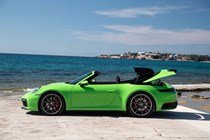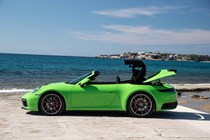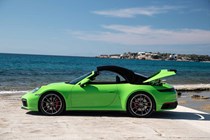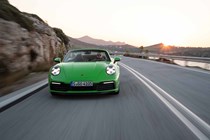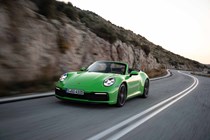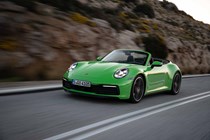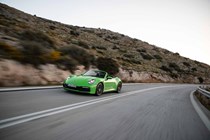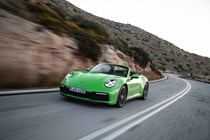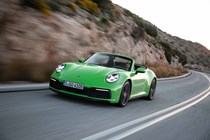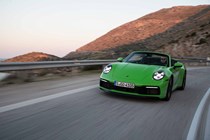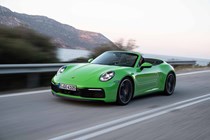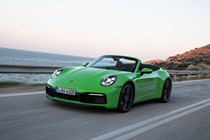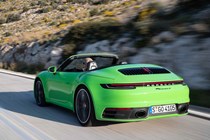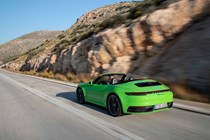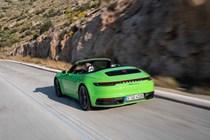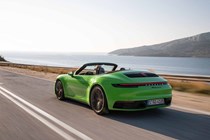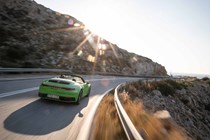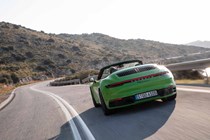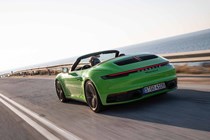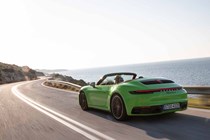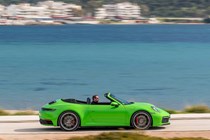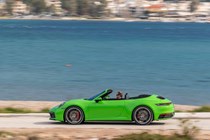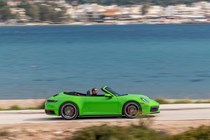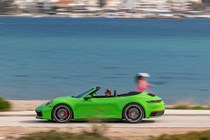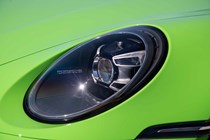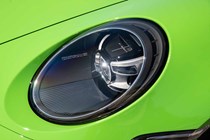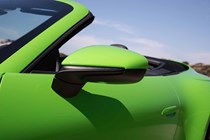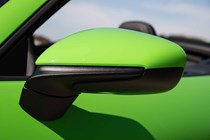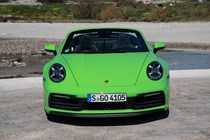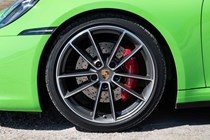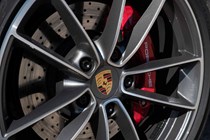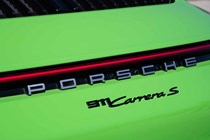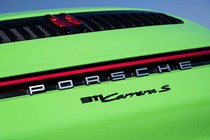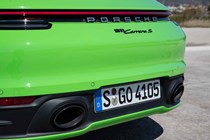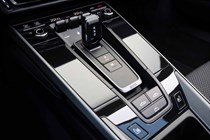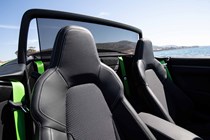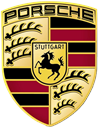
Porsche 911 Cabriolet interior, tech and comfort
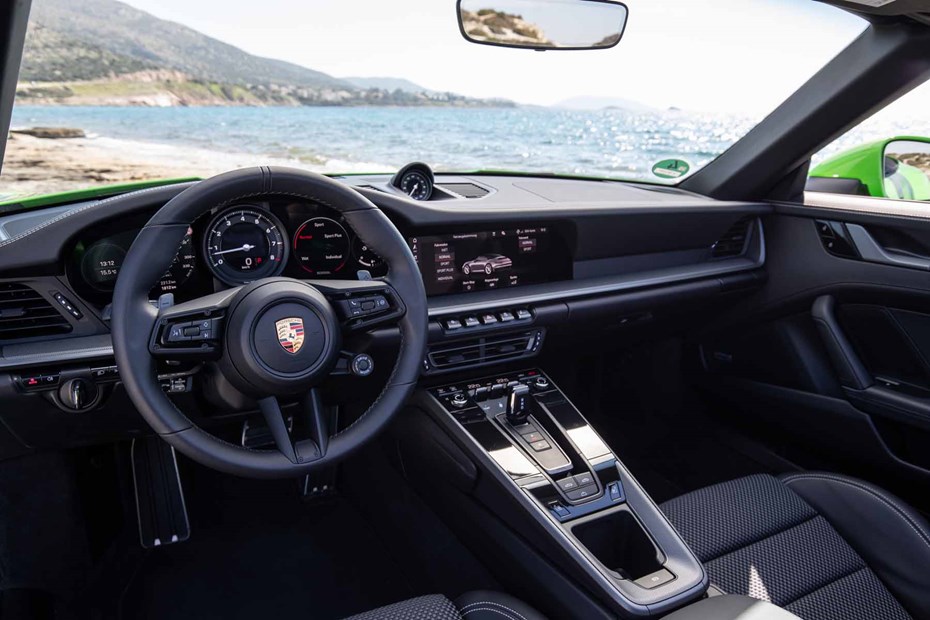
- Stronger dashboard design
- Cleaner control surfaces
- Loads of connectivity tech
Porsche 911 drivers know what they like in a cabin and this 911 is firmly fixed in that ethos – with its strong, horizontal design, lack of distracting clutter, and clear, informative dials dead ahead.
You still get a massive analogue rev counter, although it’s flanked by 7.0-inch screens, as has now become the norm for Porsche cars. There has also been a massive button cull, with a hugely simplified centre console that focuses the mind specifically on driving, rather than fiddling about.
Redesigned door cards continue the swoop of the dashboard’s trim and blend into the heavy-duty door handles – all of this means more areas to personalise your 911, whether you want wood or carbonfibre detailing.
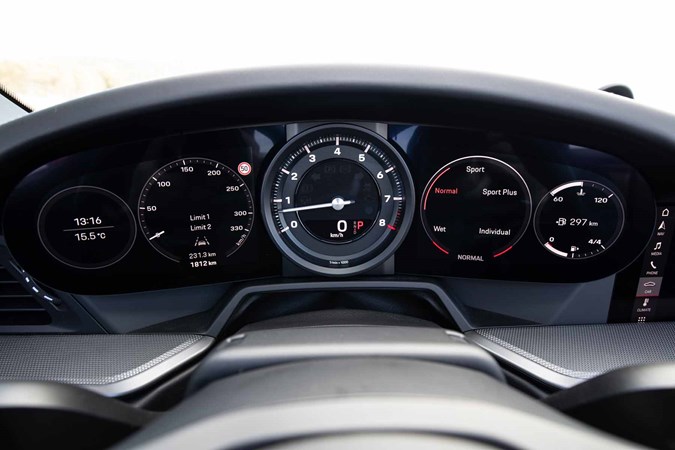
The partial-leather interior comes in black or slate grey, while a full-leather option adds blue and red, with contrast stitching if so desired.
Leather loops to fold the front seats down were inspired by historic 911 models while even the backrests can be personalised with a wide range of trims including leather, wood, brushed aluminium or carbonfibre.
Lower driving position, cleaner controls
You sit 5mm lower than before and behind a steering wheel that wears its multifunction elements more subtly – hopefully sating drivers who prefer a wheel to control the steering and nothing else.
The drive mode selector has been redesigned for better ease of use – we think it’s much less flimsy feeling than before, but still not quite as good as a Ferrari Manettino. Previously this dial had four positions for each of its drive modes, now it’s merely a toggle that cycles through drive modes displayed on one of the driver’s screens.
Not only that, but the automatic gearbox selector lever benefits from a reduced size and range of motions – you now simply move it forwards or backwards one or two notches to select drive, neutral or reverse, rather than clunking it through multiple planes. It’s not perfect though and we’ve spoken more about this in the Handling section.
New PCM touchscreen
Front and centre in the dashboard is the flush-mounted 10.9-inch Porsche Communication Management display. You can rest your hand on the trim surface in front, which actually stretches across the dash like a small shelf for knick-knacks, to use the touchscreen controls.
Alternatively there are five physical buttons for jumping straight to various vehicle functions, a bit like in a Peugeot 3008. A comparison Porsche probably won’t revel in.
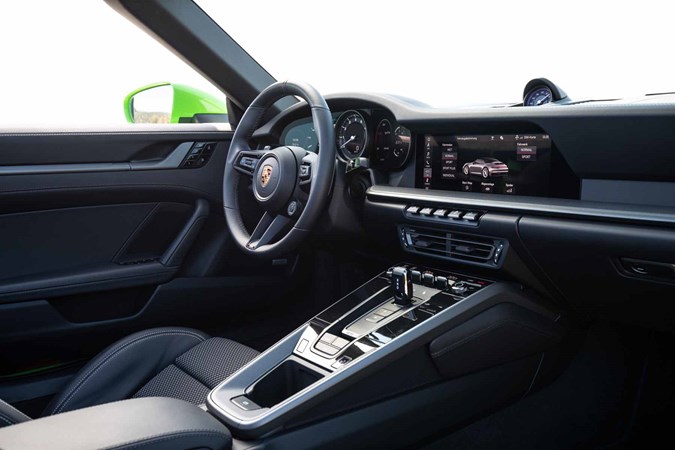
Separating the switch gear in this car from the French one though is a comprehensive palette of knurled surfaces that would impress a Bentley owner – everything from the gearshift to the air vents is covered in that high-grip finish. It looks really great.
It’s also much easier to use the PCM than before thanks to the ability to set up tiles on the home screen, including favourite radio stations, sat-nav destinations, telephone numbers or even the sports exhaust activation.
You can also split the screen with sat-nav and phone function for example, as well as swipe scrolling and pinch-in and -out operations, just like a smartphone.
Connectivity as standard
Porsche Connect Plus and an LTE-capable SIM card now comes on all cars and can be used for Amazon Music, smart home app Nest, and Radio Plus web radio.
This also enhances the online navigation function with real-time traffic information – now you can search for destinations rather than having to remember the address, plus prices for things like fuel and car parks as well as hotel and restaurant reviews can be accessed.
Traffic information comes courtesy of futuristic-sounding ‘swarm data’ – anonymously recorded and transmitted information from similarly equipped vehicles on the road about fog, slippery roads and crashes.
Finally the Porsche Connect app for Apple and Android smartphones gives you all sorts of connectivity options including the ability to programme the sat-nav from outside the vehicle.
- Clever roof insulates noise and temperature
- Pop-up wind deflector reduces roof-down noise
- Body-hugging seats improve comfort levels
The biggest question here is whether the Porsche 911 Cabriolet is any less comfortable than the Coupe – a problem often suffered by drop-top cars due to wobbly body stiffness and increased wind noise with the roof up or down.
Porsche says its clever multi-layer roof provides acoustic comfort – and headroom – broadly similar to the Coupe thanks to lots of insulation and rigid panels inside, and we agree. There’s loads of headroom and you can easily have a conversation even at motorway speeds. All the mechanism’s oily bits are covered up too, which is a nice touch.
Put the roof down and wind rustle is kept in checked by an integrated, electrically operated wind deflector, which pops up from rear seat area in two seconds even at motorway speeds by pushing a button in the centre console. No getting out the car and faffing about with a fold-up deflector for you.
There’s also the option to spec an ioniser, which filters out germs and pollutants in the air via the climate control system. Obviously it’s not much use when you’ve got the roof open.
New seats and engine mounts improve comfort too
Although lighter than before by the tune of three kilograms, the 911’s seats offer more lateral support around the shoulders and a 5mm lower setting for a road-skimming position.
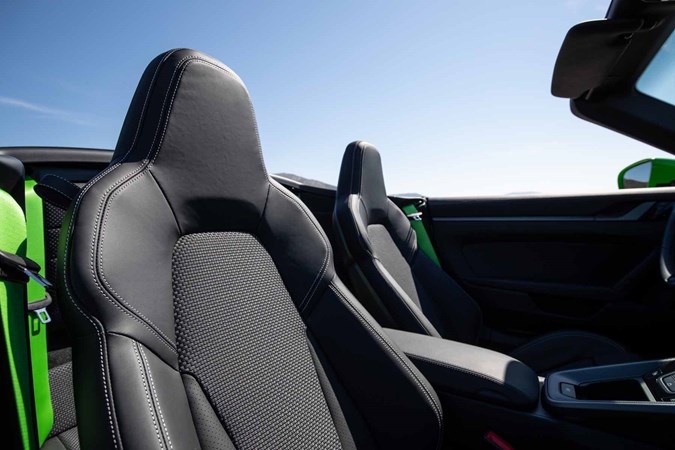
In theory this combination means you’ll be flung around less even in fast cornering, aiding lower back comfort as well as enhancing the 911’s dynamic appeal. The standard leather seats are quite firm but will undoubtedly give a little with time, whereas the optional fabric seats are softer and also even grippier, too.
Those in the rear don’t miss out – they now benefit from a 20mm higher backrest and wider seat cushion, although it’s still quite snug back there – fine for young children but you wouldn’t want to make an adult you like sit back there.
Optional sports chassis is quite firm
We’ve only driven the 10mm lower sports chassis and in truth it’s quite firm at low speed, as you’d imagine, although the clever dampers do a good job in ensuring it doesn’t crash around.
Finally the Cabriolet features new engine mounts that not only improve the handling of the car but also reduce vibrations sent through the chassis from the engine and when driving over poor surfaces.


